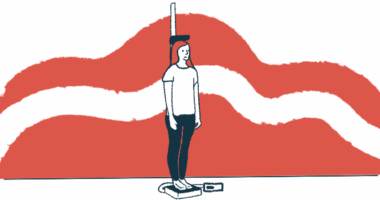MDA 2023: Translarna may help preserve motor function in DMD
'Significant treatment benefit' seen in people with nonsense mutation DMD

Treatment with Translarna (ataluren) helps to slow the decline in motor function for people with Duchenne muscular dystrophy (DMD) caused by nonsense mutations, according to new clinical trial data and analyses presented this month at the Muscular Dystrophy Association’s MDA Clinical & Scientific Conference.
The work was funded by Translarna’s developer, PTC Therapeutics.
In DMD, mutations in the DMD gene disrupt the production of the dystrophin protein. Nonsense mutations, which cause up to 15% of DMD cases, are a specific type of genetic change that introduces an early “stop” signal in the DMD gene, which prevents a full-length protein from being made.
Translarna is available in the EU, Brazil, and Russia, but not in the US
Translarna is a daily oral therapy designed to help cellular molecular machinery skip over this early stop signal, allowing production of full-length dystrophin protein. The therapy is conditionally approved in the European Union as well as Brazil and Russia, among other countries. An application for the therapy in the U.S. was rejected in 2017.
PTC is conducting a clinical trial called Study 041 (NCT03179631), which enrolled 360 boys, 5 and older, who have DMD caused by a nonsense mutation. Participants were given Translarna or a placebo for 72 weeks, about 1.5 years.
At the MDA conference, Craig McDonald, MD, from the University of California Davis, shared results from the trial in a talk, titled “Safety and efficacy of ataluren in nmDMD patients from Study 041, a phase 3, randomized, double-blind, placebo-controlled trial.”
The study’s main goal was to assess the effect of treatment on six-minute walk distance (6MWD), a common measure of walking ability. Results showed that, by the end of the study, the 6MWD was 14.4 meters (about 47 feet) further for patients given Translarna compared to those given the placebo, a 21% difference.
Among patients who had a low 6MWD at the start of the trial (defined as between 300 and 400 meters, or about 1,000 to 1,300 feet), the difference between Translarna and placebo was even more pronounced — 24.2 meters (nearly 79 feet), or 30%.
Translarna “led to a statistically significant treatment benefit in the [overall] population and the 300 to 400 meter subgroup,” McDonald said.
[Translarna] preserves muscle function, assessed by multiple clinical meaningful endpoints, in patients with [nonsense mutation] DMD.
Fewer patients on Translarna than on placebo lost their ability to walk
Analyses suggested that 6MWD scores declined more slowly among patients given Translarna: the time to a 10% decrease in 6MWD was significantly longer for these patients (median 74 vs. 48 weeks). Markedly fewer patients given Translarna lost the ability to walk during the study, compared with the placebo group.
Safety data from Study 041 suggested that treatment with Translarna was generally well-tolerated, with no treatment-related serious side effects reported. Results showed a “very similar safety profile with the previous randomized clinical trials that have been conducted internationally on” Translarna, McDonald said.
In his presentation, McDonald also highlighted published data from the STRIDE registry (NCT02369731), an observational study tracking outcomes for patients treated with Translarna. A comparison of findings from STRIDE with data from natural history studies suggested that patients treated with Translarna retained the ability to walk for longer (until a median age of 17 vs. 13 years).
In a separate analysis presented at the MDA conference, researchers pooled data from Study 041 with findings from two earlier clinical trials that tested Translarna against a placebo: Study 007 (NCT00592553) and Study 020 (NCT01826487). The poster was titled “Ataluren preserves muscle function in nmDMD patients: a pooled analysis of results from three randomized, double-blind, placebo-controlled trials.”
The analysis included data for a total of 354 nonsense mutation DMD patients given Translarna and 347 given a placebo.
Results showed that, after a year of treatment, 6MWD was significantly higher for patients given Translarna than the placebo, by an average of 19.3 meters (63 feet). For patients who started with a lower 6MWD, the difference was more pronounced at 34.9 meters (114 feet).
Other measures of motor function, including the North Star Ambulatory Assessment and the time it took patients to go up or down four steps, also showed significantly slower decline with Translarna compared to the placebo.
These findings “demonstrate that [Translarna] preserves muscle function, assessed by multiple clinical meaningful endpoints, in patients with [nonsense mutation] DMD,” the scientists concluded in their abstract.
Translarna found to preserve upper limb function
In a third presentation at the MDA conference, researchers pooled data from Study 041 with data from 261 patients in the STRIDE registry to assess the effect of Translarna treatment on the Performance of the Upper Limb (PUL), a standardized assessment of arm and hand function.
The poster was titled “Ataluren Preserves Upper Limb Function in nmDMD Patients From Study 041, a Phase 3 Placebo-Controlled Trial, and the STRIDE Registry.”
Results showed that the change in PUL over the course of the study tended to favor Translarna over the placebo, but the difference was not statistically significant in the overall group. However, the difference was statistically significant for patients who started with low 6MWD scores, where the change in PUL total score with Translarna was on average about one point better than with the placebo.
Comparisons against historical patient data suggested that patients on Translarna tended to go longer before they lost certain arm functions, like the ability to raise their hands overhead or move their hands to the mouth.
“These results indicate that [Translarna] may preserve upper limb function in patients with advanced [nonsense mutation] DMD,” the scientists concluded in their abstract.








